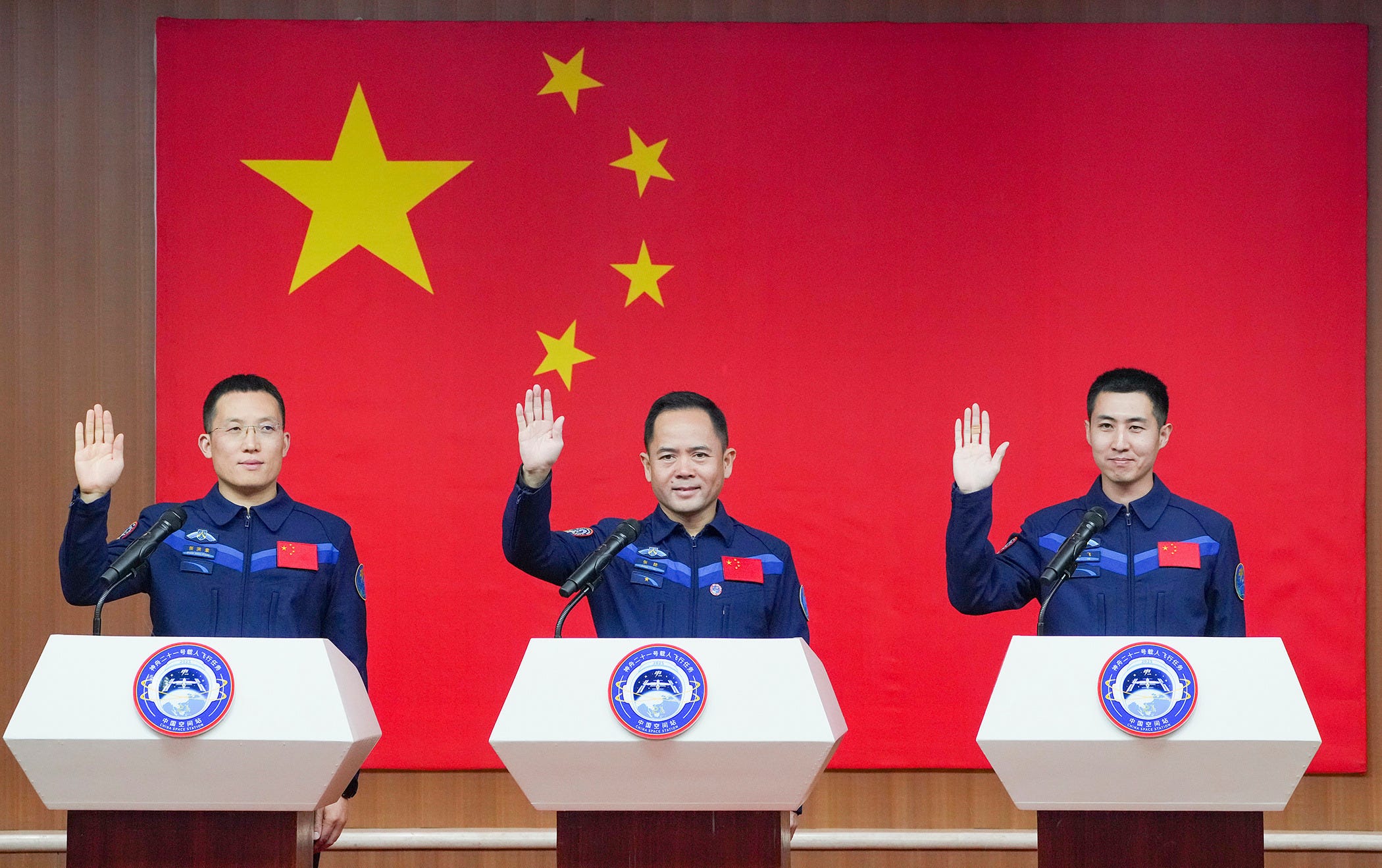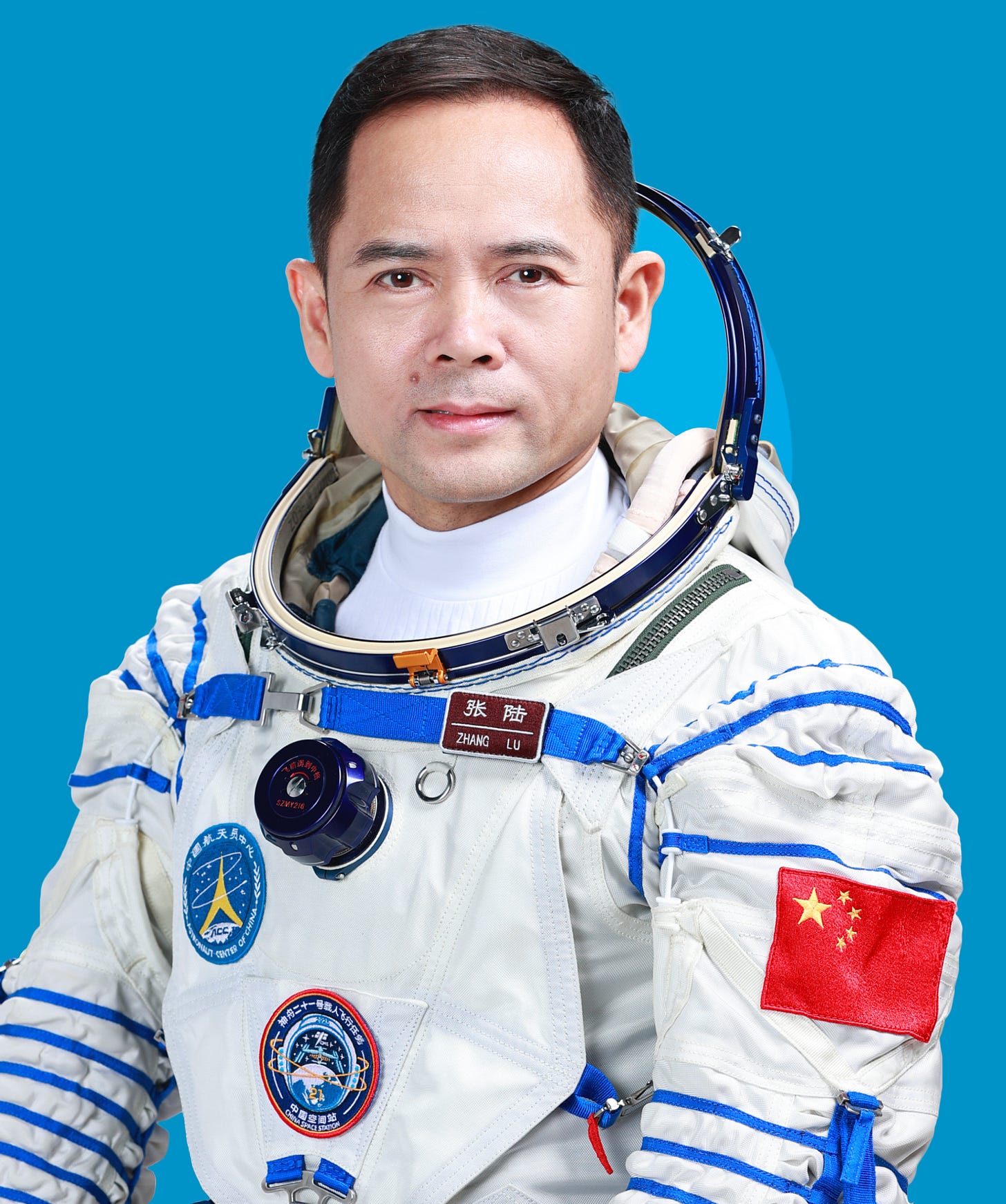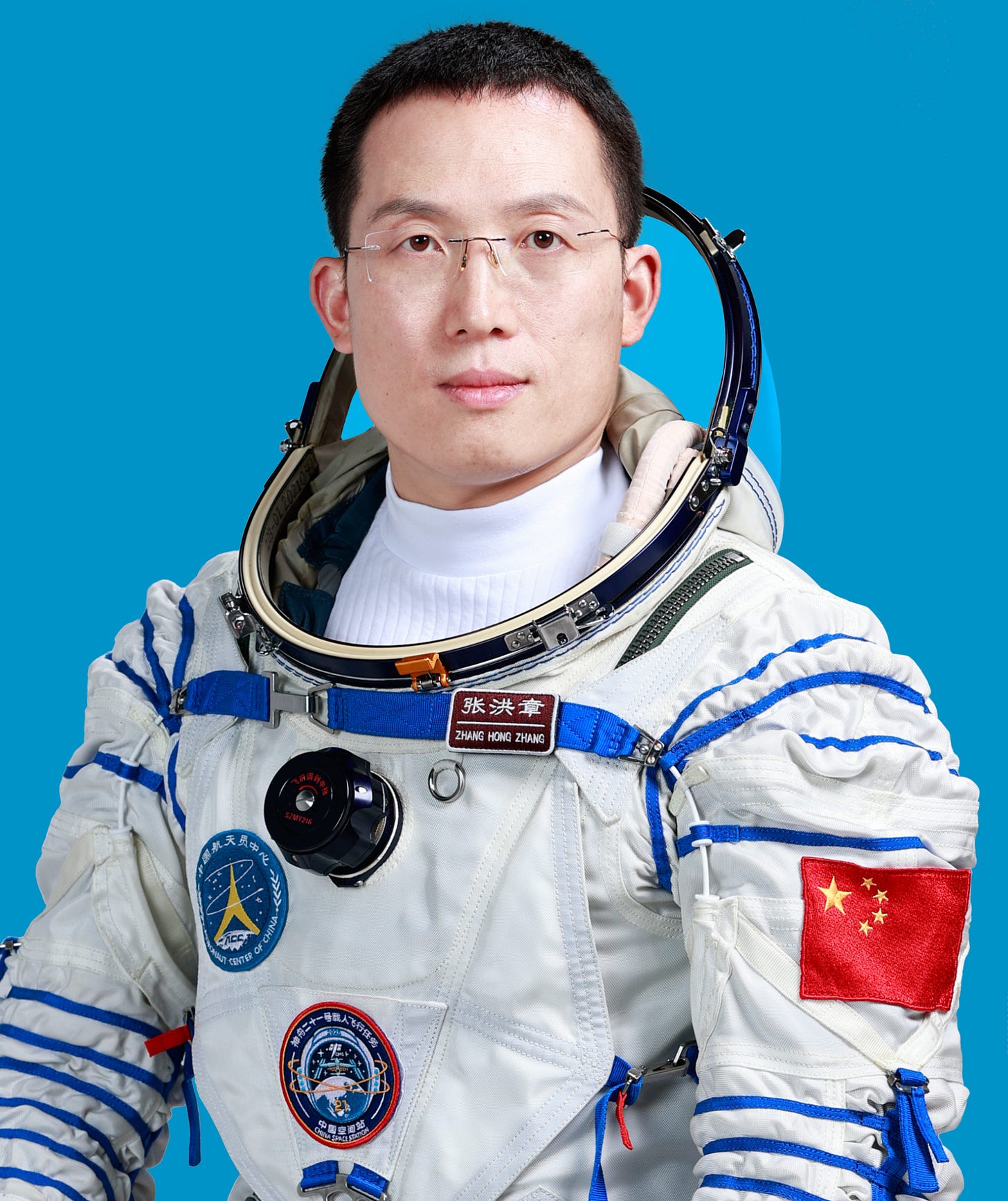Zhang Lu Will Lead Shenzhou-21 Mission to China's Tiangong Space Station
The China Manned Space Agency provided updates on Shenzhou and lunar missions.

Ahead of the launch of the Shenzhou-21 mission to the Tiangong Space Station from the Jiuquan Satellite Launch Center in just over one day (October 31st, 15:44 Universal Coordinated Time liftoff), the China Manned Space Agency has hosted its two pre-launch press conferences with its management and the three taikonauts flying onboard. Information shared during those press events is detailed below.
Meet the Shenzhou-21 trio
The first item on the space agencies’ agenda was the announcement of the three taikonauts flying onboard, with the crew consisting of one member with space experience and two first-time flyers.
Zhang Lu (张陆)
Zhang Lu is the Commander and Pilot of the mission for his second spaceflight, having flown for the Shenzhou-15 mission between November 2022 and June 2023. He is from Hanshou County (汉寿县), Hunan (湖南) province, and was selected as part of China’s second taikonaut group in 2010, also being considered a ‘post-70s’ taikonaut having been born in November 1976.
When asked about the importance of leading his second mission with younger crew members, Zhang responded:
“Two years later, I represent China again to march towards space to carry out the Shenzhou-21 mission. So I’m full of expectations, and I’ve been a student in the past two years, learning all kinds of new knowledge, especially those concerning the features of the space station. For example, I did a lot of underwater trainings, although it was very arduous and difficult, I told myself to carry on during this mission’s difficult hardships, so I want to salute to all the taikonauts and specialists, and professionals.”
“I also have the [opportunity] to share some of my experiences with science enthusiasts, especially kids, and I see their eyes light up when I talk about my life in space, and I felt that the spirit of the Chinese aerospace has been carried on. I focus on all the missions in the past two years, and I look forward to listening to the commanders saying, so I want to say hello to all of those signals, and this is Shenzhou-21, and here I am.”
“I’m born after the 1970s with two great teammates, one born after 1990s, taikonaut Wu Fei, and also taikonaut Zhang Hongzhang, born after 1980s.”
“Wu Fei is the engineer and is really outgoing and brings a lot of [energy] to the team, and he [has a] really good sense of humour. He makes a lot of things more interesting and is passionate, and [able to bring that energy] to be a joy to the team.”
“Zhang Hongzhang has a long history in chemistry, he also has a lot of hobbies like growing plants and reading. The thing about having a [six-month trip] in [Tiangong], he will carry out the experiments and, at the same time be growing plants, while also reading or even writing poems. That could be a really great paradigm.”
“Tomorrow we will go to the space station, and we are ready; we are also fully prepared. We will firmly bring to our minds the mission and the aspiration to bring our flag to shine even brighter, and also use the full success to report to the country and the people.”
Before becoming a taikonaut, Zhang served in the People’s Liberation Army Air Force and achieved the rank of Senior Colonel. He also joined the Communist Party of China in April 1999.
Wu Fei (武飞)
Wu Fei is the Flight Engineer for this mission, which will be his first trip into space. He is from Baotou (包头市 / ᠪᠤᠭᠤᠲᠤᠬᠣᠲᠠ), in the Inner Mongolia Autonomous Region (内蒙古自治区 / ᠥᠪᠥᠷ ᠮᠣᠩᠭᠣᠯ ᠤᠨ ᠤᠨᠥᠪᠡᠷᠲᠡᠭᠨ ᠵᠠᠰᠠᠬᠤ ᠣᠷᠣᠨ), and was selected as part of the third taikonaut group in October 2020, while being considered a ‘post-90s’ taikonaut having been born in 1993.
Wu is China’s youngest spacefarer to date too. When asked about that by the media and his role, he said:
“As the youngest in the astronaut corps, I am really, really lucky to perform my mission, and also my luck should give credit to the leapfrog development of our mission and the space station [as] the most shining star. Because of these developments, we have the opportunity to, on behalf of our motherland, to go to the space station, and that should give credit to all the staff working behind the scenes.”
“I already had my dream [of space] when studying at university and participated with experiment equipment for the space mission, and after several rounds of selection, I was finally [joining] the corps. There’s no shortcut; I just like to work really hard to [persevere], so I studied in theoretical physics and worked on [hundreds of pieces of equipment] under the great challenge and extreme conditions. I did not really relax as I knew we should pursue the fine details to complete the mission. I understand that as long as you work hard, you will be lucky.”
“For my personal dream, also embodied in the national mission, I believe this is the great opportunity given by the time, and what I can do is give my one hundred percent [effort] and work to pay back the trust.”
“As the flight engineer for this mission, my tasks are mainly the maintenance and management of the space station combination as well as maintaining the upgrading the equipment. This mission would not be possible without the wisdom and expectations of all the professionals working in the field. I’m there to make sure all equipment is running smoothly. According to my commander, we’ve been training together for over a year, so we have a clear division of labour to work closely together, we are trustworthy partners with each other. With the leadership of our commander and the support of our ground team, we are fully confident in completing [the mission].”
“At a later time, I will also be looking at our planet Earth from space, especially the beautiful landscape of our country. I will also be thinking about my family and my kid at home. I will be missing them dearly, of course. My mission will go through the Spring Festival, although I cannot go home this year, I believe that the [reuniting] of my family’s dream will be reflected in the country’s dream.”
Before his selection as a taikonaut, Wu was an engineer at the China Aerospace Science and Technology Corporation. He also joined the Communist Party of China in 2015.
Zhang Hongzhang (张洪章)
Zhang Hongzhang is the Payload Expert for this mission, with it being his first trip to space. He is from Binzhou (滨州市), Shandong (山东) province, and was also selected as part of the third taikonaut group in October 2020, while being considered a ‘post-80s’ taikonaut having been born in 1986.
When asked about the significance of being a researcher heading to space in his mission role, he replied:
“It’s my great honor to be part of the crew of Shenzhou-21 manned spaceflight. When I was a kid, my dream was to be like Qian Xuesen (钱学森) and the other scientists to empower our nation with technology. So when I [grew] up, I became a researcher focusing on the study of new materials and new energy. I feel that [scientific] discovery has its own charm, so I’ve reconfirmed my beliefs, so when in 2018, when the country began to recruit taikonauts from scientific researchers, I think my ideals had been lit up. To become a payload expert is not only a combination of my aspirations as a researcher and taikonaut, but also a combination of my personal achievements, [with those] of the country. So I was the first one to submit my application, and I was lucky enough to be selected, and now I’m selected to be part of the crew.”
“In China’s space station today, we could do experiments that would be unthinkable in the past, and to solve problems unheard of by our predecessors. So as a Chinese I am beyond proud, and so I want to thank the party and the country for cultivating me into who I am today and also all the support of the Chinese people as well as my colleagues doing scientific research, you are the reason we could be climbing new heights in scientific research, we are hand in hand in creating new marvels in China’s manned space missions. We will be carrying with us your aspirations and expectations and will fulfill this mission successfully [to] contribute to building China into a greater nation.”
“I prepared for this day for five years. Scientists and also taikonauts are the right [people] to talk about the challenges and difficulties, but also at the same time, I can witness the great contributions by the hundreds of thousands of people working in this industry. They are the [people] taking the challenges and finding the solutions; they also demonstrate the spirit of taikoanuts. Their spirit encourages us moving forward.”
“As the payload expert, I’m the person to carry out the experiment in space. So that’s regarding the space medicine and space materials and space microgravity physics, and also the new technology application. [I also] collect the data and monitor the data, and to do the analysis of all this data. To bring my own designs of experiment to space is also the dream of the scientists; I’m very lucky that the project I participated in will also be carried to the space station. I’m looking forward to carrying out that project and also to get the results.”
“I’m also honored to be [carrying out] the mission of the country in the national laboratory in space. We will do everything we can to carry out the scientific projects because all these projects are the efforts of the hundreds of thousands of people behind [them].”
Prior to being selected as a taikonaut, Zhang was a researcher at the Dalian Institute of Chemical Physics, Chinese Academy of Sciences (中国科学院大连化学物理研究所), where he explored new materials and technology for batteries. He also joined the Communist Party of China in 2004.
Shenzhou-21 plans
After launch, the first activity for the Shenzhou-21 crew will be ensuring a smooth arrival at the Tiangong Space Station. It is planned that the Long March 2F/G launch vehicle will send the Shenzhou spacecraft onto a rendezvous path that will see it arrive in three and a half hours instead of the usual six. Once in close proximity, the Shenzhou-21 mission will dock at the Tianhe module’s forward docking port.
Twenty-seven experiments are set to be conducted during the six-month mission, including in areas of space life science and biotechnology, space medicine, space material science, microgravity fluid physics and combustion, and new space technology. One experiment will see Tiangong host its first rodent residents, with two male and two female mice being sent up to study their behaviours in microgravity.
Besides experiments, the trio will conduct spacewalks to install hardware and inspect the Tianhe, Wentian, and Mengtian modules. They will also oversee the arrival of the Tianzhou-10 cargo spacecraft.
Mission Commander Zhang Lu also hinted at a surprise set for the Spring Festival (春节) in February, with it said to blend technology and tradition.
Tiangong updates
Activities of the soon-to-return Shenzhou-20 crew were mentioned. China Manned Space Agency officials said that the crew, Commander Chen Dong (陈冬), Operator Chen Zhongrui (陈中瑞), and Science Operator Wang Jie (王杰), completed four spacewalks to fully equip the Wentian module with meteorite and debris protection. They also placed seven sets of experiments outside via the Mengtian modules’ cargo airlock and the station’s robotic arm. While participating in the mission, Chen Dong has become the first Chinese spacefarer to spend more than four hundred days in orbit.
Usage plans for the five Feitian (飞天航天服) spacesuits onboard Tiangong were disclosed too, with two new ones having been delivered aboard Tianzhou-9. At the moment, plans are to phase out the most used suit and instead use its improved replacement. Eventually, it will also be returned to Earth onboard a ‘newly developed’ spacecraft, either Mengzhou or the Haolong (昊龙) spaceplane.
Taikonauts from the Hong Kong and Macao Special Administrative Regions had a brief mention too, with management saying that they have integrated well into China’s astronaut corps while passing through relevant training programs, like desert survival and launch site evacuation, having completed theoretical study and psychological evaluations. What missions they may fly on was not said.
Similarly, Pakistan’s astronaut is set to fly to Tiangong was spoken about. It was stated that two candidates are undergoing final selection by the Pakistani government, with the flight assignment set to take place in China. It was again said that they will fly a ‘short’ mission as a payload expert.
Lunar program progress
Lastly, China’s crewed lunar landing program was briefly discussed. According to the officials, testing and construction work are progressing smoothly, with all prototyping work completed for the Long March 10 rocket, Mengzhou (梦舟) crew capsule, Lanyue (揽月) lunar lander, Tansuo (探索) rover, and the Wangyu (望宇) lunar space suit. For the Long March 10, first and second-stage static fires were stated to be completed.
In the near future, an in-flight abort test for Mengzhou, integrated Lanyue tests with Tansuo, and a low-altitude flight of the Long March 10 series are planned. A little further beyond, the Mengzhou-1 mission is in the planning stages ahead of a mission in 2026 (likely atop a Long March 10A), with China Manned Space Agency opening a design competition for its logo soon. No timelines for the mission or tests were stated, remaining on the official ‘before 2030’ goal for the entire program.
Ahead ot the launch, planned tests, team drills, and launch rehearsals have been completed following the Long March 2F/G’s rollout to the launch pad on October 24th. Participating in the pre-launch preparations were teams from the China Academy of Launch Vehicle Technology, the China Academy of Space Technology, and other entities under China Aerospace Science and Technology Corporation.
What is the Shenzhou spacecraft?
The Shenzhou spacecraft is China’s only operational crewed spacecraft and is currently used to ferry its crews to and from the Tiangong space station. The spacecraft has a pressurized volume of almost fifteen cubic meters with a habitable volume of seven cubic meters. Currently, the Shenzhou spacecraft has a crew capacity of three.
Shenzhou consists of a service module, a re-entry module, and an orbital module. The only part of the spacecraft that the crew cannot access is the service module, which also houses the four main engines for performing in-space maneuvers. For generating power, the Shenzhou spacecraft has two solar wings with four panels each that are unfolded after launch, a rotating fixture also attaches them to the service module.
During launch and return to Earth, the crew is seated in the re-entry module. The re-entry module is the only part of the spacecraft that can survive the heat of re-entry and has parachute systems and a landing motor to safely land after return from space. Inside the module, the crew can take control of the spacecraft, access some of the cargo stored during launch and landing, and look out the windows from their seats.
The Shenzhou spacecraft currently launches on the Long March 2F/G rocket from the Jiuquan Satellite Launch Center. Each Shenzhou spacecraft has a believed launch weight of 8,100 kilograms and an in-space mass of 7,840 kilograms.







